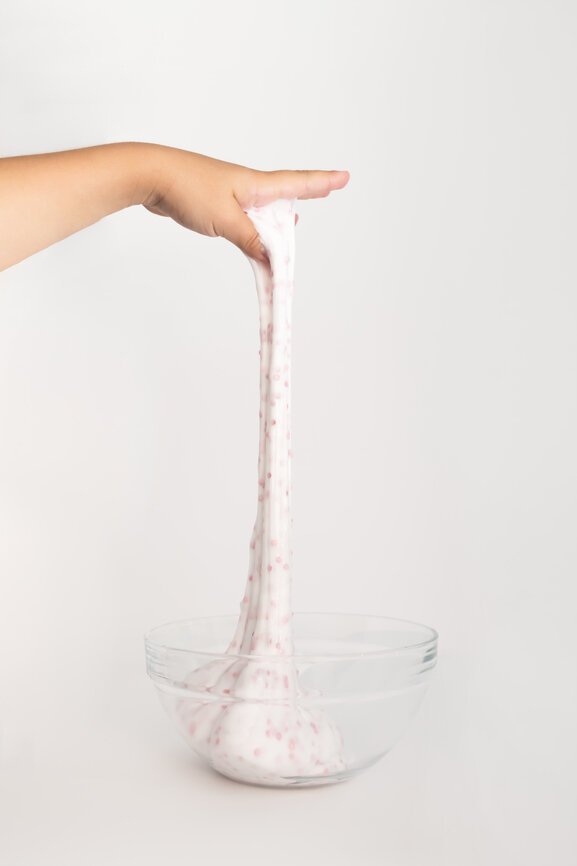
How To Make Biodegradable Slime At Home
What’s so great about slime?
If you’re not yet familiar with the weird ways of the internet, let me introduce you to the world of slime. An extension of ASMR, slime videos are meant to soothe and delight viewers. Instagram accounts like @slime and @slimeobsidian curate videos that play with every combination of texture, color, and sound imaginable. If you’re not instantly repelled, you may find yourself drawn in for extended periods of time.
But the fun doesn’t stop there. Touching and feeling slime is just as delightful. It can even go beyond messy play—many people, myself included, find calming benefits to the entire experience. This is because slime is a sensory activity: it removes us from screens, prioritizes stillness, and focuses on tactile, visual, and auditory experiences (which can all be part of a mindfulness practice).
“Slime removes us from screens, prioritizes stillness, and focuses on tactile, visual, and auditory experiences.”
Unfortunately, slime isn’t the most sustainable activity. While you can easily find it online, the ingredients may deter you from purchasing. Homemade slime isn’t much better, since most recipes include Borax, glue, styrofoam beads, aerosol shaving cream, and excessive amounts of non-biodegradable glitter. All this adds up to a not-so sustainable hobby. So, are we relegated to just watching videos on our phones forever, or is there an eco-friendly option?
Of course there is! Here’s how I make slime without using glues or harsh chemicals.
A Recipe For Biodegradable Slime
1 ½ cups water ¼ cup flaxseed 1 tbsp corn starch
Pour the water into a saucepan and stir in the corn starch until dissolved. Stir in the flaxseed. Bring the pan to a simmer over medium heat for a minute, then turn off the heat and let cool for a few minutes. Repeat the simmer and cooling process a couple more times, stirring occasionally and gently, until the seeds look thick. Finally, transfer to a glass container and chill in the fridge for a few hours or overnight. If you want a thicker slime, you can knead in more corn starch a tablespoon at a time until it reaches your preferred consistency. I keep mine in the fridge for a few days and dispose of it when it starts to smell funky.
Once you have your slime, add color and texture with whatever eco-friendly or biodegradable ingredients you have on hand. Here are some ideas:
-
Tapioca pearls
-
Rice or dry beans
-
Minced herbs or cut flowers
-
All natural food coloring (watch out for stains!)
-
Marbles, beads, or seashells you can wash and reuse later
For mindful play, set aside quiet screen-free time to swish the slime around in the bowl, squeeze it, and let it slip through your fingertips. I find slime calming after work; it allows me to focus on the physical experience and brings me back into my body after a day of staring at screens.
If there are other slimy materials you like, have some fun experimenting! I made a couple batches of slime using aquafaba, the liquid you drain from a can of chickpeas (or the leftover water after cooking them from a dry state). Whip it by hand or in a stand mixer—adding a couple of squeezes of lemon juice to help it foam up a bit—and add flaxseed from there. If you’re worried about how to dispose of non-boiled seeds, you can grind them up in a coffee grinder to prevent unwanted sprouts or sticky seeds in your sink or compost bin.
Slime Alternatives
At the end of the day, slime gets handled excessively, then disposed of. There are other excellent sensory projects that can be more productive and less wasteful if you have the time!
For a close slime-like experience, try your hand at making bread. Kneading, shaping, and braiding the dough can activate the same senses as slime does—plus, you get a warm loaf of bread at the end. Or, if you have a sweet tooth and are particularly adept in the kitchen, make pulled sugar or ribbon candy. Not hungry? Try air-drying clay and using it to make your own home decor items or beads.
Gardening, and all the digging and mixing that comes with it, can be therapeutic as well. Aside from getting you outside and growing your own food, research has found many physical, psychological, and social benefits to growing and maintaining a garden.
If you want to avoid sticky messes, tangible activities like painting, crocheting, or other crafts can help your mind unwind. (Paint color mixing is another ASMR-friendly video hole you can fall into.) Alternatively, explore these screen-free creative hobbies.
We all need a little release right now, and scrolling Instagram or TikTok endlessly won’t help us unwind—even if we are watching slime videos. Find the tactile activity that ignites your brain and energizes your hands, and give your eyes a little break from a screen. They, and you, deserve it.
What other screen-free hobbies do you love? Share in the comments below!
RELATED READING
Emily Torres is the Managing Editor at The Good Trade. She’s a Los Angeles transplant who was born and raised in Indiana, where she studied Creative Writing and Business at Indiana University. You can usually find her reading or writing, caring for her rabbits, or practicing at the yoga studio.

